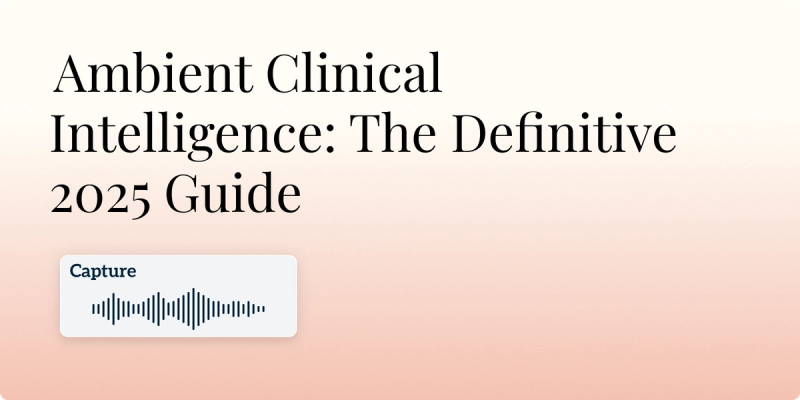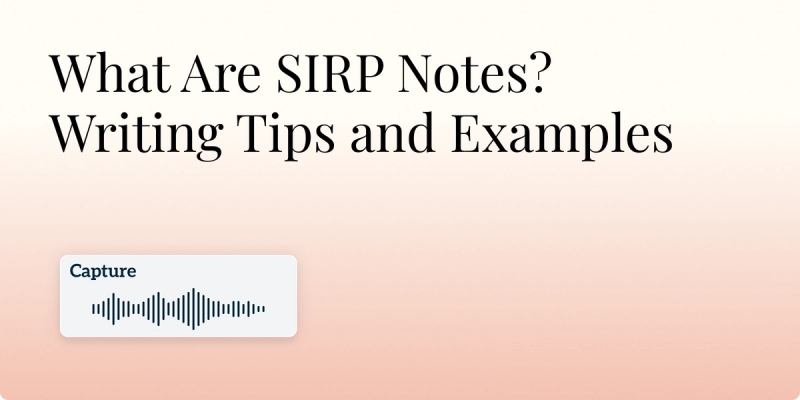
Ambient Clinical Intelligence: The Definitive 2025 Guide for Healthcare Leaders

1 . What Is Ambient Clinical Intelligence?
Ambient Clinical Intelligence (ACI) refers to AI‑powered systems that unobtrusively capture the patient‑clinician conversation, generate a structured medical note in real time, and push it into the EHR without human scribes. It combines automatic speech recognition (ASR), large language models, and clinical knowledge graphs to understand context, surface insights, and even draft orders.
Synonyms you may see: ambient AI, ambient listening, AI medical scribe, conversational clinical AI.
2 . Why 2025 Is the Tipping Point
- Mass adoption: Analysts estimate the global ambient intelligence market will reach USD 37.2 billion in 2025, climbing past USD 91 billion by 2030 (20 % CAGR). Mordor Intelligence
- Cloud‑scale LLMs: Microsoft’s acquisition of Nuance accelerated enterprise‑grade ACI, with new DAX Copilot features sending structured conversation data directly into Microsoft Fabric for analytics. Source
- Capital inflows: Abridge alone closed a USD 150 million Series C to scale its ambient listening platform.
Bottom line: 2025 is no longer early adoption—ACI is becoming table stakes for health systems seeking productivity and clinician‑wellbeing wins.
3 . How Ambient Clinical Intelligence Works
- Audio capture via smartphone or room mic with patient consent.
- Speaker diarization & medical ASR convert dialogue to text.
- Generative AI & templates produce a draft SOAP, CCD, or narrative note.
- Clinical NLP & coding engines map problems, meds, ICD‑10, CPT, and quality codes.
- Provider review loop (typically < 60 seconds) before final sign‑off.
Advanced platforms add real‑time prompts (“Ask about red‑flag chest pain”) and workflow triggers (e.g., auto‑order labs).

4 . Proven ROI & Time‑Saving Data
Metric | Outcome | Source |
|---|---|---|
Documentation time per note | ↓ 75 % (from 12 min to 3–4 min) | |
Primary‑care documentation burden | ↓ 28 % per encounter | |
Net “pajama time” after hours | ↓ 70 % | |
Daily minutes saved | 35 min per clinician | Geisinger data |
Burnout reduction (self‑reported) | 55 % | Geisinger data |
EHR note time vs. baseline | ↓ significantly month 1 |
Pro tip: When you multiply 35 minutes saved per clinician by the fully‑loaded hourly cost of a physician (~USD 200), ACI pays for itself in weeks, not years.
5 . Key Use‑Cases by Specialty
- Primary care: Rapid SOAP notes, health‑maintenance prompts.
- Psychiatry / behavioral health: Long narrative visits benefit from automatic reflection of patient affect and quotations.
- Orthopedics & surgery: Auto‑capture of laterality, implant details, and post‑op plans.
- Telehealth: Single microphone captures both sides of a virtual call and writes the note before the session ends.
- Emergency medicine: Ambient triage quickly hands off to downstream teams.
6 . Vendor Landscape & Evaluation Checklist (2025)
Vendor | Differentiator | Key Metrics to Request |
|---|---|---|
Twofold Health | HIPAA‑compliant, self‑service SaaS built for outpatient practices; flat‑rate pricing; short note generation times and speciality based workflows and templates. | Minutes saved per note, note‑acceptance rate before edits, customization options, integration lead‑time with your EHR, pricing predictability |
Microsoft Nuance DAX Copilot | Deep EHR integrations (Epic, Cerner), Azure compliance | Time‑saved, note accuracy, latency |
Abridge | “Linked Evidence” maps every line of the note to transcript audio for audit | Quality metrics, language support |
DeepScribe | Focus on midsize hospitals; strong nephrology & gastro templates | Specialty coverage, cost per note |
Oracle Health (Cerner) | Native agent inside Oracle EHR; claims 30 % documentation reduction | Independent validation |
Suki Ambient Mode | Voice‑assistant plus dictation fallback | Workflow flexibility |
Evaluation questions
- Does the model run on‑device, in the cloud, or hybrid?
- How is PHI encrypted (at rest & in transit)?
- What is the evidence‑traceability of generated content?
- Can it output FHIR‑structured data for downstream analytics?
- What is the pricing model—per‑note, per‑minute, or per‑clinician?
7 . Implementation Best Practices
- Patient consent workflow: Add a one‑tap consent in the intake form and display a visible “Recording” indicator in the room.
- Change‑management: Run a 4‑week pilot with high‑volume clinicians; show them time‑saved dashboards weekly.
- Privacy & compliance: Require vendors to sign a BAA and provide SOC 2 + HIPAA reports.
- Shadow charts first: Let the AI run in “ghost” mode for two weeks to benchmark quality before going live.
8 . Future Trends & Predictions
Trend | Timeline | Why It Matters |
|---|---|---|
Real‑time diagnostic nudges (“Ask about β‑blockers”) | 12–24 months | LLMs reach FDA‑cleared decision support class. |
Multi‑modal ambient (video + audio) | 18 months | Adds wound images, gait analysis. |
Ambient OS layer | 24 months | Vendors move from just notes to full‑visit workflow orchestration (orders, prior auth, billing codes). |
30 % of U.S. docs using ACI | End 2025 | Forecast from leading founders interviewed by Fierce Healthcare |
9 . Expert Quotes
“We are at an inflection point where AI breakthroughs are fundamentally changing the way we work and live.” – Joe Petro, Corporate VP, Microsoft Healthcare
“Freeing doctors from the burden of documentation will dramatically improve both quality of care and the doctor–patient relationship.” – Paul Ricci, former CEO, Nuance Communications
“This company was founded on the premise that clinician‑patient conversations are at the core of all healthcare… Already, this information is powering a revolution in AI‑based documentation.” – Dr. Shiv Rao, CEO, Abridge
“Documentation now takes me about a quarter of the time.” – Dr. Terrance Wickman, Nephrologist, Ochsner Health
10 . Conclusion
In 2025, Ambient Clinical Intelligence consistently trims documentation time by up to 75 %, frees an average of 35 minutes per clinician each day, and slashes after‑hours “pajama time.” These gains directly improve revenue, patient throughput, and clinician well‑being—making ACI a strategic imperative, not a luxury.
See the impact for yourself—schedule a 15‑minute demo with Twofold Health and start your free trial of our HIPAA‑compliant ambient AI scribe today.
Frequently Asked Questions
ABOUT THE AUTHOR
Dr. Eli Neimark
Licensed Medical Doctor
Reduce burnout,
improve patient care.
Join thousands of clinicians already using AI to become more efficient.

What Are SIRP Notes? Writing Tips and Examples
Learn how to write SIRP notes with examples, templates, and tips to document therapy sessions effectively and track client progress.

Why AI Notes Sometimes Sound Off – And What You Can Do About It
AI-generated notes sound robotic or inaccurate? Learn the common causes and practical steps to refine your AI’s output for clinical clarity.

Best AI Note Takers for Psychologists (2026): 6 AI Scribes Ranked
Compare the best AI note takers and AI scribes for psychologists in 2026. See pros, cons, pricing, HIPAA notes, and clinician feedback.

